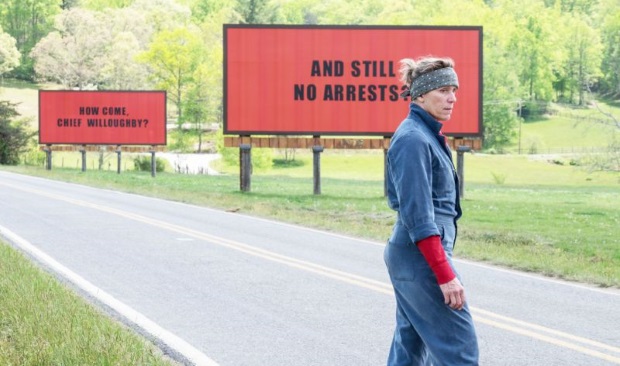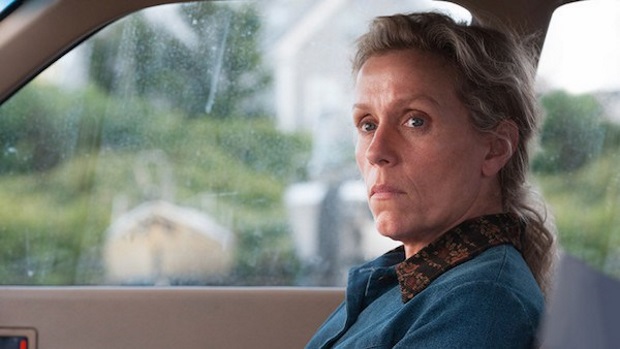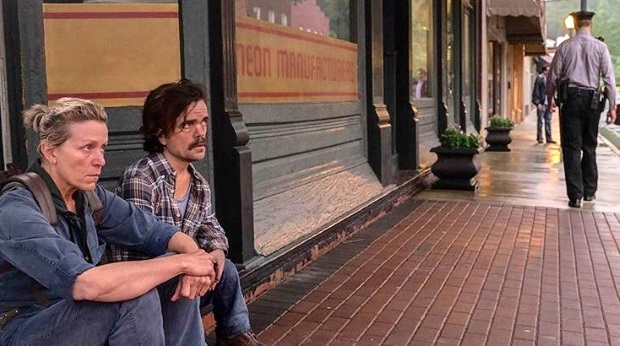Martin McDonagh interview: Three Billboards Outside Ebbing, Missouri
In Bruges director Martin McDonagh chats to us about his new film, Three Billboards Outside Ebbing, Missouri...
After securely establishing his credentials in the theatre, Martin McDonagh became an insta-cult film director with the unforgettable, much-loved In Bruges. He’s only now just releasing his third feature film in almost a decade, but Three Billboards Outside Ebbing, Missouri delivers generously on McDonagh’s immediate promise as a writer for screen as well as stage.
We spoke on the telephone last year, about this film, about what McDonagh plans to do next, and also about the lessons McDonagh learned from Seven Psychopaths.
One of the things that interested me most about this film is what it says about language. The first weapon we see wielded is words, then there’s a lot of discussion of what we ‘can’ and ‘can’t’ say, and the characters definitely use language in a weaponised way.
There wasn’t a conscious decision to say something about language in this film in particular but most of my characters, even in my plays, come around to talking about the way we talk about things rather than just talking about things. I might be very PC in my real life but I don’t believe that I need to be so on stage or screen, it’s much more interesting to try to capture how people in these situations actually do speak, without any kind of judgement or holding back. This also allows the scene between Frances and Sam in the interrogation room where the ‘n word’ is used; if a person was determined to not use that word in the film, that would cut out the point of that scene which is about the racism. Unless you’re free to point that out, even in a very sarcastic way almost, you’d lose the power of a scene like that.
Thinking about the words on the billboards themselves, did that take a lot of drafting? How hard was it to get them right?
Not at all, and I’ll tell you why. It’s because I saw something on a bunch of billboards about twenty years ago which is almost identical to what we see on the first two billboards, they’re literally verbatim.
Did you look into that case? Have you researched it?
I tried to but it was twenty years ago and you couldn’t [back then], and I didn’t know exactly where it was. It’s a tricky thing to Google.
I imagine we’ll hear some more about that story now.
Maybe, and that would be interesting. I was on a bus going somewhere through the southern states, it could have been Georgia, it could have been Alabama, I’m not sure where the bus was and literally in the blink of an eye, it passed me by. Almost like a dream – but it’s not, I definitely saw it. I’d be intrigued to hear what the true story was.
Before the words get put up we see the billboards in their dilapidated form. I’m imagining they were quite carefully designed.
We wanted something quite old fashioned. The town itself felt like it hadn’t changed since the 40s or the 50s so we wanted the billboards in their original state to have that kind of feel, and to be colourful, maybe even hopeful, despite their state of disrepair. It contrasts with the starkness with the new version, the red and the black. We wanted something to draw the eye, pictures… and then we thought about what billboards in that region would have: tourist information, mountains, ‘go visit the blah blah blah’. And we’re setting this in the Ozark region, so something about welcoming people. But it’s mainly about them being beautiful though dilapidated.

My wife is from Kentucky so I have been to some very small American towns and your town seemed authentic, but how real is? How constructed is it?
Imagewise? The town we filmed in is Silver in North Carolina. It’s basically a one-street town that looks like what you see in the film. We turned a furniture store into the police station and the office across the street into our advertising office. There wasn’t too much difference made there and pretty much everything else is how we found it. All we did is take away anything that made it too modern: any neon that wasn’t our neon, anything that jumped out as being very 2017. The look we wanted was a town that hadn’t changed at all since 1950 and won’t have changed very much in 30 years time if people see the film then.
You seem to be building up a rep company, The Martin McDonagh Players.
Exactly!
Did you have this troupe in mind for these roles? And does that influence the way you write?
It was written for Frances and it was written for Sam, then it was only after the script was finished that I thought ‘Who could play that?’ and ‘Who could play that, that I’ve worked with before?’ so it’s not that it’s written for, for instance, Zeljko who plays the desk sergeant. But once it’s on the page I’d think, as I’ve used Zeljko twice before, once in a film, once in a play, ‘Where can I put Zeljko in that would work?’
And all of the smaller parts you think ‘Who was in Seven Psychos that I love?’ so Amanda Warren, who plays the black friend of Mildred, she played Tom Waits’ wife in the previous film. That was an easy go-to because she’s a great actress.
And Woody, obviously. The good thing about it is that they’re all friends, even if they’re coming in for just a couple of days, we already have shorthand. I think that shows with even the smaller characters in the film. They’re quite relaxed and quite real.
I’m very interested in how you first discussed the role of Mildred with Frances and your initial conception of who Mildred is and how she should be approached, how that came out through your discussions.
One of the important points was that we wouldn’t sentimentalise her, we wouldn’t make her softer, more motherly, and would completely go for how strong, intelligent, outrageous and provcative she is. We never wanted to make her nicer, more palatable. Even though she’s technically the hero of the piece she does things that are way out of order, indefensible. That’s part of why I really like her, the character and Frances’ playing of her, she’s really three dimensional and not somebody you could say is the perfect person at all. That’s good characterisation, I think, and makes it hopefully a film you can see more than once. It’s not a simple heroes against villains story.
Conversely, Sam’s character starts off as someone who is totally reprehensible – or seemingly so – but it’s his change is almost the most interesting one.

You say he starts as totally reprehensible but for the first few seconds he’s incredibly charming – at least until he does anything.
Yeah! When he’s on his own he’s fine.
In your work with Ben Davis, your cinematographer here, are there any principles or rules you laid down for how the film was going to be shot?
We’ve both got an intense love for American films of the 1970s so we wanted to make one ourselves, at least to a degree. Our discussions were about keeping as much camera movement in as we could but not going crazy. We knew this was a character drama and more about the people than the camera moves so we didn’t want it to be showy. Apart from that one shot, the big shot where Sam goes in and beats up… well, I wanted that to be an unbroken shot.
Why?
For the cinema of it. But also the drama and the danger of following a violent person, knowing he’s going into a place where something bad is going to happen and never getting a cut away to release the tension.
That’s a kind of Alan Clarke thinking.
Exactly. And we pulled it off. I always hate phony… when things purport to be an unbroken shot but you know when it passes a window frame that there’s been a cut. Computers have allowed us to make a stink that these shots are unbroken.
So you’re promising this is a single take.
100%. We spent weeks planning and we thought it would take… we weren’t sure we’d be able to pull it off, but in the 4th or 5th take, we got it and so we had to find something else to do for the rest of the day. It’s not just steadicam up the stairs, down the stairs back and anything can go wrong with that, but there’s also big stunts involve, make-up changes and costume changes that you don’t necessarily see. Punches to the face that need to be pulled off, and cars stopping – so many things that could have gone wrong but none of them did, everybody did their job so brilliantly. It’s my favourite shot in the film.
You’ve got people lurking off camera rushing in and touching up Caleb’s face…
There’s one kind of magic trick, almost. Try and work out how we did it.
You can’t leave us hanging like that.
Watch it closely and see how we did it.
So can I say that there’s more than two people in the scene?
Aha! Not bad, not bad.
One of the most interesting formal decisions, and we can see how the story feeds into this, is that people of colour are marginalised in the frame until… well, until they’re not, and they’re brought very much into the centre. This town has marginalised them, and later Clarke Peters turns up and it all starts to pay off – then after the badge he’s centre frame.
That was part of the thinking, that’s true. We wanted a picture of… well, you might know this from Kentucky too, a lot of towns, even today, are black towns or white towns. The affluent towns we saw were all white and the more run-down towns were all black and that was shocking to see in the present day.
Truly a symptom of America’s malaise. Beyond just ‘a problem’. Terrible.
Yes.
Can we talk about Carter Burwell’s music? I assume you spotted the film with him and told him what you wanted. Do you remember what those conversations were about?
I leave Carter to it, to a degree. I like a nice tune so I always hope he’ll come up with one. He came up with the idea of it being a spaghetti western, Mildred like a John Wayne character coming into town to sort out the bad guys. The theme that pops up as soon as we see Mildred is quite the Sergio Leone-type tune. When I heard it I thought ‘fuck me, that’s brilliant’ because it wasn’t something I had really thought about. It certainly gives the film more of a Western feel than I thought it was going to have.
And that goes on top of what Frances was thinking about the character, which was using John Wayne as a template for the attitude and specifically her walk. I’m not a huge John Wayne fan – I prefer Montgomery Clift – but I see the western in the finished film and Carter’s music pulled that out.
What ambitions do you have left? What haven’t you been able to pull of so far that you’re keen to do?
It’s more about just keeping the standards up to this level. I was happy with In Bruges, less so with Seven Psychopaths, but I think this is up to the In Bruges level or above it, so it’s about not fucking up any more. Not working too often but having each one be this sort of standard.

So what have you learned by looking at Seven Psychopaths and the fact that you’re not entirely happy with it?
A realisation that it should be all about character and empathy with the characters you create, that the actors create, rather than the meta, smart-ass stuff. I’ve learned not to be such a show-off and to have a bit more empathy with humanity. Or at least to fake that.
What keeps you up late at nights these days? What might you be interested in writing about next?
Lesbians. Lesbians are keeping me up at night… I’d like to do something with two strong female characters, two strong women leads, after this one.
And lots of women behind the camera would be great too.
Yeah, exactly. There were a lot more women behind the camera on this, almost none on Seven Psychopaths. Maybe that shows in the quality of the film we made. I hope so.
Martin McDonagh, thank you very much.
Three Billboards Outside Ebbing, Missourri is in UK cinemas from January 12th.